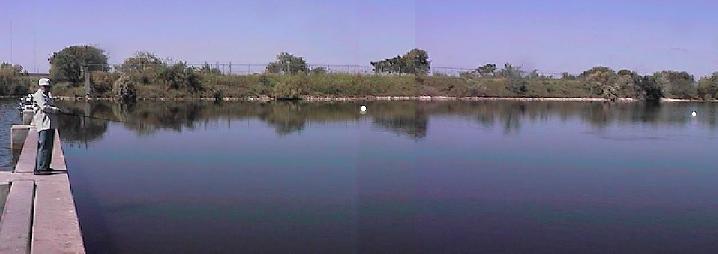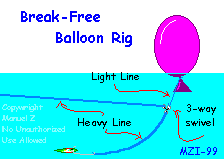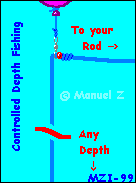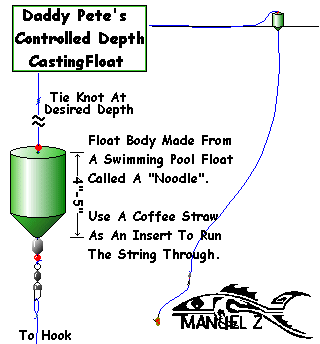

By:
Manuel Z
Updated: November 10, 2001
Fishing live or cut
bait far away from shore is a great way to hook up with large fish.
Fishing with a balloon attached to your line simply takes the
place of floats or bobbers. For the price of one float you could
buy a package of 50 to 100 balloons depending on the quality you
want to use (I use Helium grade balloons which cost about $2.00
for about 25 nine inch balloons). The key is to have the wind or
current positioned so it pushes the bait away from you and
towards the target area. There are many ways to use a balloon as
a fishing device, You don't have to blow the balloon up all the
way, just blow it up big enough to hold up your weight and to
give a little resistance when you get the BIG BITE! If you blow
it too tight it will burst after a short while. This comes in
handy sometimes. (More on that later) You can use a balloon close to shore
as a regular bobber also, the same as you would a float at a dam, Or below a rapids
in a river.
NOTE: This method isn't always a good idea,
especially around other fishermen, when the wind is blowing at an
angle. Then it's just more of annoyance than anything else.
Just remember to be considerate of other Fisher(persons).

The pictured balloons are coming from the boats behind
this fisherman.
Here are a few techniques I use frequently.
STANDARD BALLOON RIG
The standard rig is simply to tie a balloon to your line
which would be set up any way you want it, From a free swimming
live bait all the way to a heavy leader with a chunk of cut bait.
You tie the balloon up the line as deep as you want to fish, I
set mine around 5 to 6 feet deep but I'm casting with a 10 to 15
foot rod. Of course this means you would already have to be in
deep enough water to accommodate your balloon placement. I use
this method off steep shoreline drop offs, Piers, Docks. Remember
boats frequently use the docks so expect your line to get tangled
in someone's propeller, or to have an upset boater to deal with.
THE BREAK FREE RIG
 Use
3 way swivels with VERY light line going to the balloon. When it
gets out far enough, Give it a good Yank to bust the light line
and release the Balloon, This will cause your bait to sink to the
bottom a lot farther out from shore than you could cast it.
Another option is to just let it sit there and when there is a
strike, the light line will break and release the balloon. (I
know this isn't very "NATURE CONSCIOUS") So I have an
alternative method that takes a bit longer.
Use
3 way swivels with VERY light line going to the balloon. When it
gets out far enough, Give it a good Yank to bust the light line
and release the Balloon, This will cause your bait to sink to the
bottom a lot farther out from shore than you could cast it.
Another option is to just let it sit there and when there is a
strike, the light line will break and release the balloon. (I
know this isn't very "NATURE CONSCIOUS") So I have an
alternative method that takes a bit longer.
ALTERNATIVE METHOD
Blow the balloon as tight as possible, Tie it directly
to your line and set it out, Try and get as much line out as you
can, as fast as you can. The reason we are rushing is because in
a short while the sun is going to increase the pressure in the
balloon and soften the rubber causing it to burst and your rig
will sink weather you're ready or not. This depends on the
weather conditions, it could take anywhere from 20 minutes to
just over an hour for the balloon to burst. (And it stays tied to
your line without littering nature!) This is the method I use
more frequently than others.
 CONTROLLED DEPTH
CONTROLLED DEPTH
Controlled depth fishing is where you have a knot on your line
such as the UNI-KNOT. I just cut the line the depth I
want to fish then re-connect the line with a UNI-KNOT, My preference is 20 feet, add a bead, A swivel then your leader
or however you would like your line rigged the purpose of the
bead is to make your balloon goes no further than the knot in your
line. My Father taught me how to use this method for catching
Blue Catfish and Redfish in a Stocked Lake although he sometimes uses a 20
ounce plastic soda bottle for his float. Some fishermen use this
method while drifting in a boat this way they can have a couple
of fishing rods with lines right off the boat and a couple more lines further away from the boat during the drift.
 My
Father "Daddy Pete" has developed a LARGE
Slip float I call the "DPF" (Daddy Pete Float) which works
extremely well because it will hold up large/heavy weighted rigs with no
problem, it can be cast much farther than a Balloon rig. If you click the above
link or the drawing you can see how it works and how to make your own. These
floats are very large and very light. I have also been experimenting with
putting weights into the tips of the floats so I can cast the float out and use
a much lighter weight to pull the line through to my desired dept. This way if
using a live bait it can swim a bit more freely. (If you make some of these
floats, Take pictures of you using them and send them in!)
My
Father "Daddy Pete" has developed a LARGE
Slip float I call the "DPF" (Daddy Pete Float) which works
extremely well because it will hold up large/heavy weighted rigs with no
problem, it can be cast much farther than a Balloon rig. If you click the above
link or the drawing you can see how it works and how to make your own. These
floats are very large and very light. I have also been experimenting with
putting weights into the tips of the floats so I can cast the float out and use
a much lighter weight to pull the line through to my desired dept. This way if
using a live bait it can swim a bit more freely. (If you make some of these
floats, Take pictures of you using them and send them in!)
 BACK
ONE PAGE
BACK
ONE PAGE
Back to Alternative Fishing Methods